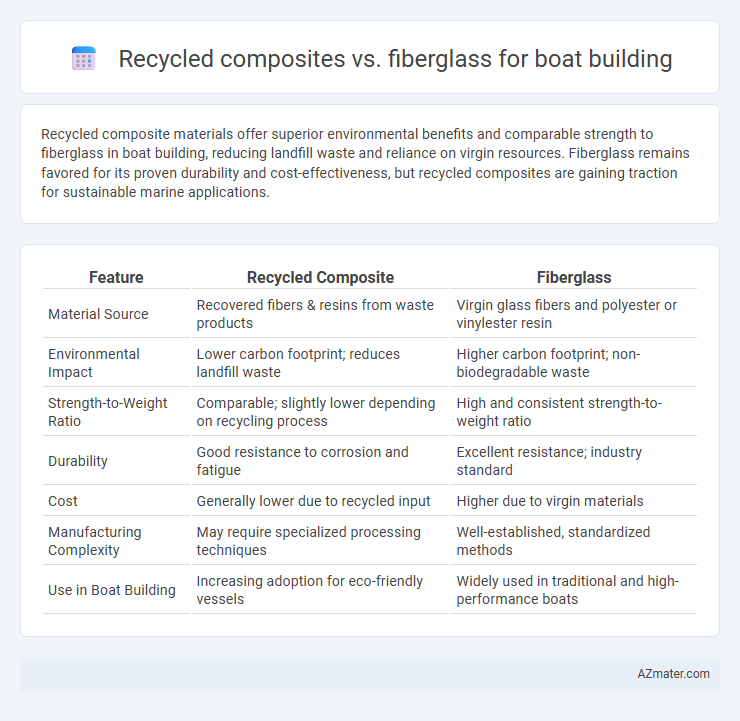Recycled composite materials offer superior environmental benefits and comparable strength to fiberglass in boat building, reducing landfill waste and reliance on virgin resources. Fiberglass remains favored for its proven durability and cost-effectiveness, but recycled composites are gaining traction for sustainable marine applications.
Table of Comparison
| Feature | Recycled Composite | Fiberglass |
|---|---|---|
| Material Source | Recovered fibers & resins from waste products | Virgin glass fibers and polyester or vinylester resin |
| Environmental Impact | Lower carbon footprint; reduces landfill waste | Higher carbon footprint; non-biodegradable waste |
| Strength-to-Weight Ratio | Comparable; slightly lower depending on recycling process | High and consistent strength-to-weight ratio |
| Durability | Good resistance to corrosion and fatigue | Excellent resistance; industry standard |
| Cost | Generally lower due to recycled input | Higher due to virgin materials |
| Manufacturing Complexity | May require specialized processing techniques | Well-established, standardized methods |
| Use in Boat Building | Increasing adoption for eco-friendly vessels | Widely used in traditional and high-performance boats |
Introduction to Modern Boat Building Materials
Modern boat building materials increasingly favor recycled composites and fiberglass for their strength-to-weight ratio and environmental impact. Recycled composites, made from repurposed fibers and resins, offer improved sustainability without compromising durability or corrosion resistance. Fiberglass remains a popular choice due to its cost-effectiveness, ease of fabrication, and proven performance in marine environments.
What Are Recycled Composites?
Recycled composites in boat building are materials made by reprocessing fiber-reinforced polymers, often combining reclaimed fibers such as carbon or glass with new resins to create sustainable, high-performance alternatives to traditional fiberglass. These composites offer environmental benefits by diverting waste from landfills and reducing reliance on virgin raw materials while maintaining comparable strength and durability required for marine applications. Advances in recycling technologies enable the production of recycled composites with tailored properties optimized for lightweight and corrosion resistance, making them an increasingly viable choice in modern boat manufacturing.
Understanding Traditional Fiberglass in Boat Construction
Traditional fiberglass in boat construction consists of woven glass fibers embedded in a polyester or epoxy resin matrix, providing high strength-to-weight ratio and corrosion resistance essential for marine environments. This material has long dominated the industry due to its durability, ease of molding into complex shapes, and relatively low cost. However, concerns about environmental impact and disposal have prompted exploration of recycled composites as sustainable alternatives.
Strength and Durability: Recycled Composite vs Fiberglass
Recycled composite materials often offer comparable strength to traditional fiberglass, with enhanced resistance to impact and fatigue due to their multi-material composition. Fiberglass remains a proven choice for tensile strength and long-term durability, especially in saltwater environments where UV resistance and water absorption are critical. When selecting materials for boat building, recycled composites provide improved environmental sustainability without compromising the structural integrity and lifespan of the vessel.
Environmental Impact and Sustainability Comparison
Recycled composite materials in boat building significantly reduce environmental impact by diverting waste from landfills and lowering carbon emissions compared to traditional fiberglass, which relies heavily on non-renewable petroleum resources and generates hazardous waste during production. The use of recycled composites supports sustainability through enhanced lifecycle benefits, including easier recyclability and reduced energy consumption in manufacturing processes. Fiberglass boats, while durable, present challenges in disposal and recycling, making recycled composites a more eco-friendly choice that aligns with growing environmental regulations and consumer demand for sustainable marine solutions.
Cost Analysis: Upfront and Long-Term Expenses
Recycled composite materials typically offer a lower upfront cost than traditional fiberglass due to reduced raw material expenses and lower energy consumption during manufacturing. Over the long term, recycled composites provide cost savings through enhanced durability, resistance to corrosion, and reduced maintenance requirements compared to fiberglass boats. Despite a slightly higher initial investment in some cases, recycled composites deliver greater lifecycle value by minimizing repairs and extending the vessel's operational lifespan.
Weight and Performance Differences
Recycled composite materials in boat building offer significant weight reduction compared to traditional fiberglass, enhancing fuel efficiency and maneuverability. These composites maintain comparable strength and durability, ensuring reliable performance in various marine conditions. The lower density of recycled composites contributes to improved acceleration and speed without compromising structural integrity.
Maintenance Requirements and Lifespan
Recycled composite materials in boat building offer lower maintenance requirements due to enhanced resistance to moisture absorption and UV damage compared to traditional fiberglass, resulting in less frequent repairs and surface treatments. Fiberglass boats typically require regular gel coat refinishing and periodic inspections for cracks or water intrusion to prevent structural degradation. Lifespan of recycled composite boats can exceed 30 years with minimal upkeep, while fiberglass vessels generally have a lifespan of 20 to 25 years depending on maintenance quality and environmental exposure.
Design Flexibility and Customization Options
Recycled composite materials offer enhanced design flexibility compared to traditional fiberglass, allowing boat builders to create more complex shapes and tailored structural properties through advanced molding techniques. Customization options with recycled composites include varied fiber content and resin formulations that optimize strength-to-weight ratios and environmental impact for specific applications. Fiberglass remains popular for its cost-effectiveness and ease of repair, but recycled composites provide superior adaptability for innovative, eco-friendly boat designs.
Future Trends in Boat Building Materials
Recycled composites are gaining traction in boat building due to their environmental sustainability and potential for comparable strength-to-weight ratios when compared to traditional fiberglass. Innovations in resin technology and fiber reinforcements are enhancing the durability and recyclability of composite materials, aligning with the industry's shift toward eco-friendly practices. Market forecasts predict a significant increase in demand for bio-based resins and recycled fibers, driven by stricter environmental regulations and consumer preference for greener solutions.

Infographic: Recycled composite vs Fiberglass for Boat Building
 azmater.com
azmater.com